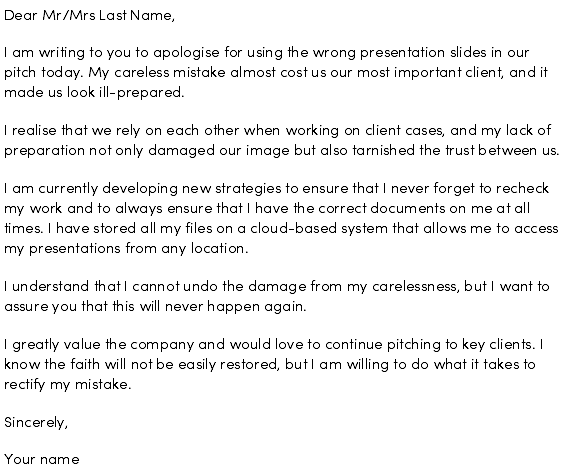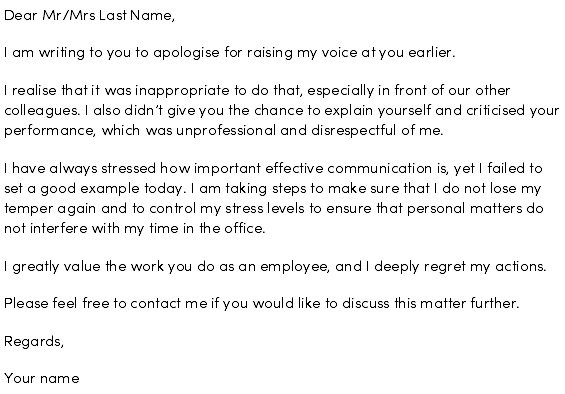While not every mistake you make at work requires a formal apology, sometimes you need to take responsibility for your actions and hold yourself accountable.
Apologising is never an easy thing to do but taking initiative shows that you are a responsible employee who values their role and company.
So, how do you go about writing a formal letter of apology? Our guide will walk you through the process of writing an effective apology letter and provide you with a number of examples.
TABLE OF CONTENTS
Why write an apology letter
Everyone makes mistakes at work, deadlines get missed, typos are made, orders are delayed - nobody is perfect. But when someone makes a significant error that could have consequences for the organisation, then it’s vital to own up to it and apologise.
These consequences may be internal – such as negatively impacting team collaboration – or external – such as damaging customer relationships.
By writing a formal letter of apology you can:
- Show your employer or customer that you are sincerely sorry about the mistake that was made
- Establish that you understand the implications of your error
- Demonstrate to your employer that you have reflected on what has happened and learnt from the experience in order to improve your work performance
- Ask for the opportunity to make amends, solve any problems created, and put things right, if possible.
Formally apologising in a letter can also:
- Provide a written record that you have taken responsibility for your actions
- Prevent a customer from taking further action or taking their business elsewhere
- Contain the situation to a reprimand and prevent substantial disciplinary action
- Help to restore your integrity and reputation in the workplace
When to write an apology letter
Writing a letter of apology is something that requires you to take initiate. Don’t wait or expect to be asked to write one as this could give the impression that your apology is not sincere.
First, take a little time to reflect on what happened before you start writing. That said, don’t leave it for too long either as this could make a bad situation worse. If you do find that you have waited a little too long to apologise, don’t abandon the task - you may feel you have missed the window of opportunity to offer an apology, but that doesn’t mean you shouldn’t address the matter.
If your apology letter is addressed to a customer or an external contact, then it should preferably be sent within a couple of days. If the letter is to your boss or a colleague, then contacting them a day or so after the mistake would be ideal, as it’s likely that you apologised in person first.
What to include
When you are writing a letter of apology, it’s important to follow a formal format. This applies even if you’ll send the letter via email. Your apology letter should contain the following components:
- Sender’s address: If you’re writing a formal apology letter, you should start with your address listed in the top right-hand corner of the page.
- Date: the recipient should know when the letter was written. If you’re writing an email, skip this step.
- Subject: You don’t need to go into too much detail here; something as simple as ‘Apology Letter’ can do the trick.
- Salutation: As this is a formal letter, you need to address the reader properly. So, even if you are on a first-name basis with your colleague or HR manager, it’s proper etiquette to open your letter with ‘Dear Becky’ or ‘Dear Ms Bennett’.
- Body of letter: this normally consists of three sections; an opening paragraph stating the purpose of the letter and stating your apology; the main part that conveys detailed information, giving a debrief of the events and acknowledging where you went wrong; the closing paragraph summating and outlining further actions.
- Closing and signature: Reiterate your apology and sign off with a formal close such as “Yours sincerely” or “Sincerely” rather than “Regards” and your name.
Tips for writing an apology letter
It’s important to maintain a good working relationship with anyone who may have been affected by your error. That might be your boss, your colleagues, your customers or other external stakeholders.
Sending them an apology in writing can go a long way by helping you clear the air and rebuild their trust. Here’re a few tips to help you put together a well-written letter of apology.
1. Use a professional format and tone
A formal written apology counts as business communication. Therefore, it’s crucial that you use a professional format and tone. That said, while a certain level of formality needs to be maintained, you can still have a friendly tone if you are on a first name basis with the person you are addressing. Make sure that your writing is concise, clear, and easy to read.
Business letters usually follow a specific layout; one of the most most popular ones is known as block format, which keeps all text left-justified and single spaced, except for double spaces between the paragraphs. This layout keeps the letter looking orderly and easy to read.
Always be genuine and sincere about your apology, if you choose to use a standard letter or template, then edit it to make it more personalised.
2. Say you are sorry
This might be obvious, but your letter should open with your apology. The first paragraph should start by saying, for example, “I apologise for…”, “I am sorry that…” Don’t be tempted to follow this with excuses or explanations, as this will only make you look defensive. Your words need to reflect that you understand the impact of your actions.
That said, you don’t need to keep apologising or exaggerating by saying things like “I am very, very, very sorry” as your apology will lose all meaning.
3. Take responsibility
Admitting to your error and taking ownership demonstrates your professionalism and sense of responsibility. Statements such as “I was wrong too...” or “I should not have…”, followed by an explanation of how you should have reacted or approached a situation allow you to own the mistake but also show that you are capable and aware of how to deal with such situations, despite this error.
4. Validate their feelings
The person you wronged, or the company itself, needs to know that you understand what happened, why, and how it affected them.
Your apology must focus on recognising your mistake, rather than deflecting any blame from falling on you.
Statements such as “Looking back, I can clearly see that…” or “It wasn’t my intension to…” can assure the reader that you recognise what went wrong, and that there was no malicious intent behind your actions.
The next step is to validate their feelings, and actions that they may take towards you, following the event. Follow these with statements such as “I understand how you must be feeling” or “I realise that it has been really frustrating for you”, both of which show that you acknowledge how they may feel about your actions.
5. Outline your next steps
You need to let the reader know how you intend to make amends. This might be an action to right the wrong such as resending information, or retyping a report. Or, outlining the steps that you’re taking to ensure that the same mistake won’t happen again. You could use statements such as “I have already implemented...” or “Should this ever happen…”.
This is your chance to show that you are committed to improving, and to start rebuilding their trust. That said, don’t make promises you can’t keep by saying things like “This will never happen again” or “I can guarantee that…” as it may be out of your control – how you react to these situations, however, is not, so concentrate on that.
6. Ask for forgiveness
Even if it hurts your pride, asking to be forgiven or to be given another opportunity to redeem yourself is crucial. The letter recipient is more likely to forgive you if you have covered all the steps above and have provided a genuine apology. This final step will also help to restore a positive working relationship.
7. Read and edit
Before you send your letter of apology you should read it, preferably out loud, to ensure that it conveys your thoughts and message as you intended.
The letter should be concise – a long rambling text weakens the overall intent. Make sure that it sounds honest and shows that you are truly sorry and that you really want to make amends.
Apology letter examples
Writing a letter of apology is never an easy thing to do. To help you write yours, we have compiled a few examples below:
Sample letter from employee

Sample letter from manager

Sample letter to client

Final thoughts
If you are responsible for a mistake made at work, then you should take accountability. Writing an apology letter is certainly a step in the right direction but keep in mind that saying “I’m sorry” won’t right a wrong.
You have set the wheels in motion to rectify the situation, but you might have to give it some time before things are back to normal.
Have you ever had to write a letter to apologise for a mistake you made at work? How did you handle it? Let us know in the comments section below.
This article is an updated version of an earlier article originally published on 31 August 2015.

